Very cool project, I'm glad someone is doing it. Although it reminds me again of how stupid it is to use MPG as a standard.
crankwalk wrote: That's a pretty neat idea with the Yoshimura. I like it
I've debated this for a custom exhaust idea on the rx7 myself, each rotor gets a bike muffler. I like the work, def something fun to keep you busy :)
fidelity101 wrote:crankwalk wrote: That's a pretty neat idea with the Yoshimura. I like itI've debated this for a custom exhaust idea on the rx7 myself, each rotor gets a bike muffler. I like the work, def something fun to keep you busy :)
I ran supertrapps on rotaries, all turbo and really liked the result. For a project like this, to maximize backpressure, it would work pretty well to tune it. BUT it would probably be too loud for the owner.
The muffler hack worked out pretty slick. The muffler had a stainless steel inlet and a cast aluminum tailpipe. It looked cool but rendered the muffler useless.
I drilled out the rivets on the extra muffler and pulled the inlet section and remounted it on the output on the better muffler. The resulting muffler now had weldable inlet and outlet. I picked these mufflers up for $35.00 at a Volkswagen swap meet. I think the ID was just over two inch.
The sound is a mellow low tone that is barely detectable at idle. The sound stays mellow all the way up to redline. I was hoping for a little more noise but the little B3 doesn’t really pump a lot of air.
I think I have been romping on the car harder than usual to sort of get a feel for the exhaust sound and performance. I have about 60 miles on the smaller exhaust and the car seems to run the same. I wasn’t really expecting any difference and was slightly worried that I would lose power. So far, everything feels good.
I’m taking the car on a mini adventure this weekend. Hopefully I can squeeze all my stuff into it.
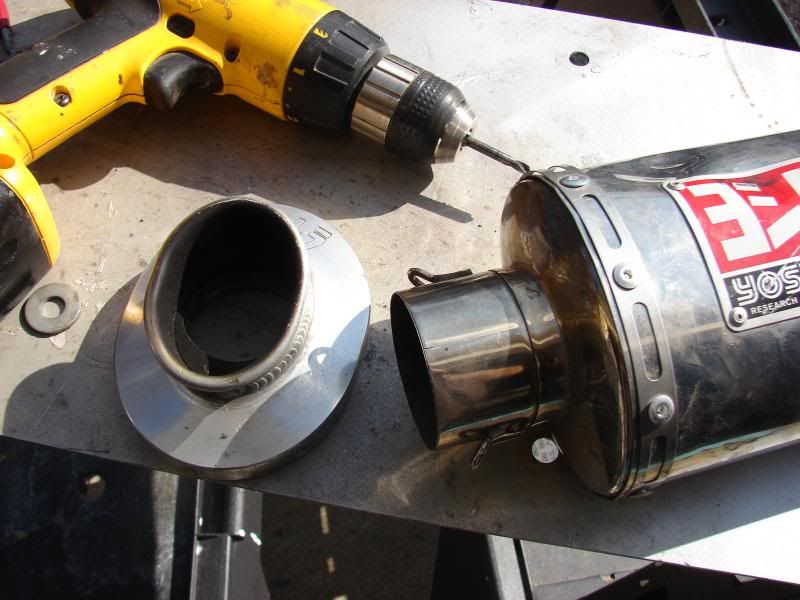 zip out the rivets and the muffler comes apart. The aluminum end cap was swapped for a stainless steel end cap. The modified muffler made it easy to weld on a proper tailpipe.
zip out the rivets and the muffler comes apart. The aluminum end cap was swapped for a stainless steel end cap. The modified muffler made it easy to weld on a proper tailpipe.
The mini adventure worked out to 130 miles round trip. Had to go through HELL to get there! Interesting enough…. Hell in April is not as warm as you would think it would be.
The car got 39 MPG and ran great! The exhaust bumps against the floor pan on extreme bumps however nothing to worry about.
Typically I encounter roadside candy on my adventures. What I mean to say is stuff for sale by the road side. Anyway, the only thing I saw for sale was an old pickup bed made into a trailer. I wonder if people are hording stuff like they did in the great depression?
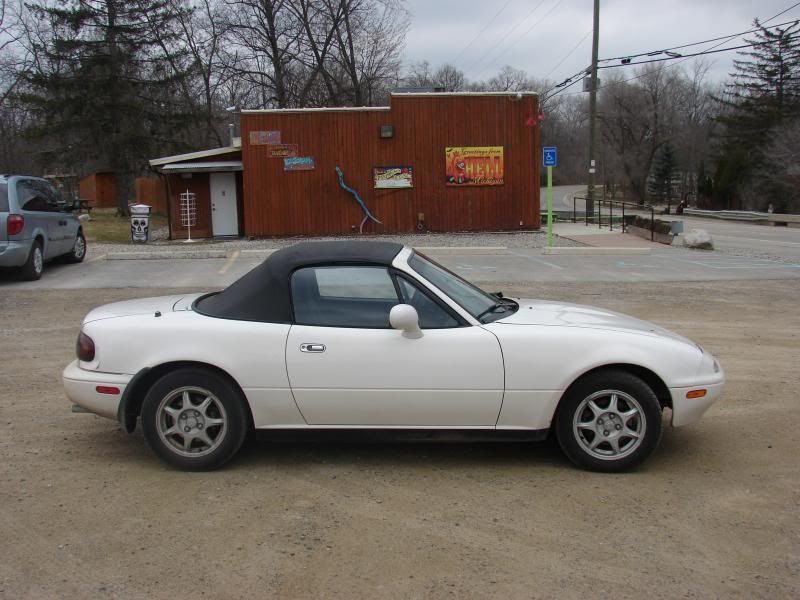 HELL Michigan is not so warm in April.
HELL Michigan is not so warm in April.
My storage tent took a hell’a beating this winter. Totally shredded the top right off. It was only 5 years old. My neighbors want to make it into a mini greenhouse, So I sold it to them for one hamburger. I ended up getting two hamburgers and ¾ of an apple pie. Not to shabby.
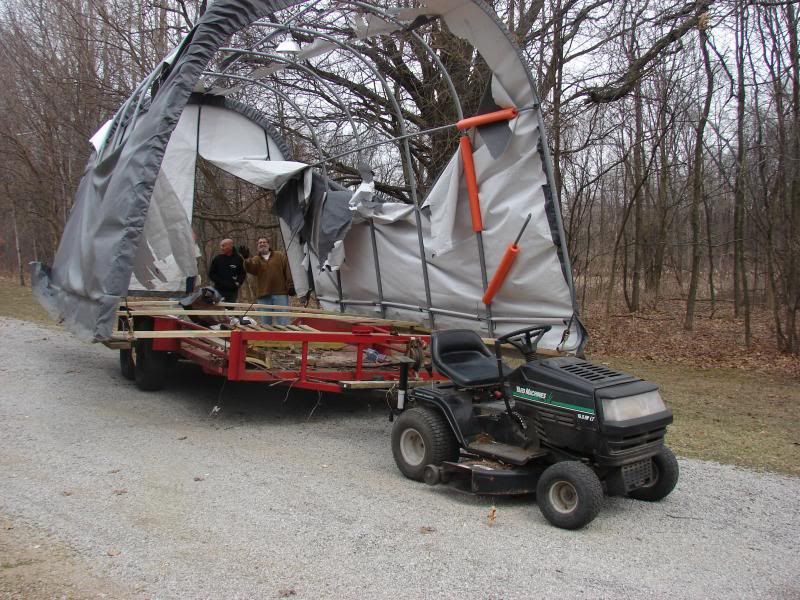 Hillbilly covered wagon making the trip to the neighbor’s house. My lawnmower is equipped with a severe duty hitch and hauled the 2000 pound trailer with the tent.. no problem!. Bill, Craig and Chuck like watch me do stupid stuff.
Hillbilly covered wagon making the trip to the neighbor’s house. My lawnmower is equipped with a severe duty hitch and hauled the 2000 pound trailer with the tent.. no problem!. Bill, Craig and Chuck like watch me do stupid stuff.
Sorry for the lack of updates. The results of my experiments tend to take a while because the car doesn’t burn much gas.
Things have been progressing behind the scenes with the MPG project. The 1.5 inch exhaust made a noticeable improvement when combine with the stock Festiva ECU.
So far the stock Festiva engine has been modified with a .20 head shave, cleaned up intake ports, slightly ported exhaust ports and a roller camshaft from an automatic transmission Aspire. The 1.5 inch exhaust is more or less a stock size for a Festiva and is not really a mod, but it does suggest the stock Miata exhaust is unsuitable.
The adjustable cam pulley is still locked down to stock settings I’ll eventually get to that experiment.
The car averaged 36 to 37 MPG. Sometime I would get higher if I kept the speed below 60 MPH. Real world numbers are all that matters.
I decided it was time to put the Megasquirt back in and do some tuning.
With the Megasquirt installed, the MPG jumped to 39-40 average. This is on last year’s tune. I only smothered out the rough edges with Megatune’s autotune feature.
A bit of tweaking got the car up to 41 MPG average.
I bumped the fuel pressure to 43 PSI and once again used autotune to clean up the VE numbers
]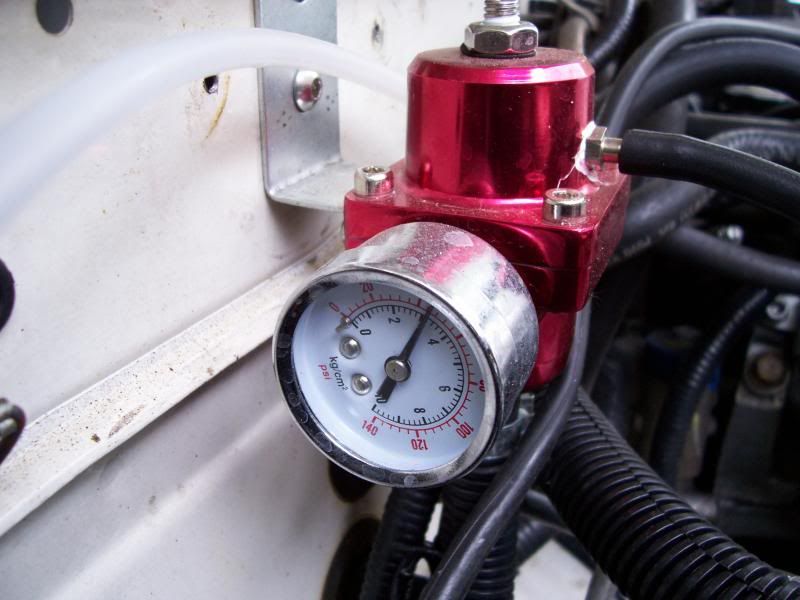
Fuel pressure bumped up to 43PSI
The average jumped to 43.5 MPG. Not too shabby. The car is capable of better MPG if driven below 50 MPH, but I exclude those numbers because they are not realistic as far as real world driving.
The CAS (crank angle sensor) on the hybrid ignition system bit the dust last week. Fortunately the car died a few hundred feet from my driveway. The good news is, I was able to tow the car back to the house with my lawnmower.
I was forced to drive my Saturn for a few days. The Saturn has become a test bed for some of my experiments and it gets 40.5 MPG average per tank. Perhaps I’ll start another thread and share some of the ideas.
Anyway, back to the Miata….
While the car was disabled, I took the opportunity to do some “aero” mods. I’m a bit conservative with altering the looks of the Miata and limited the mods to cleaning up the bumps and stuff.
In My opinion, Miata back bumpers look like a loaded diaper. They hang too low and bulge out a bit. I decided to do a bumper chop.
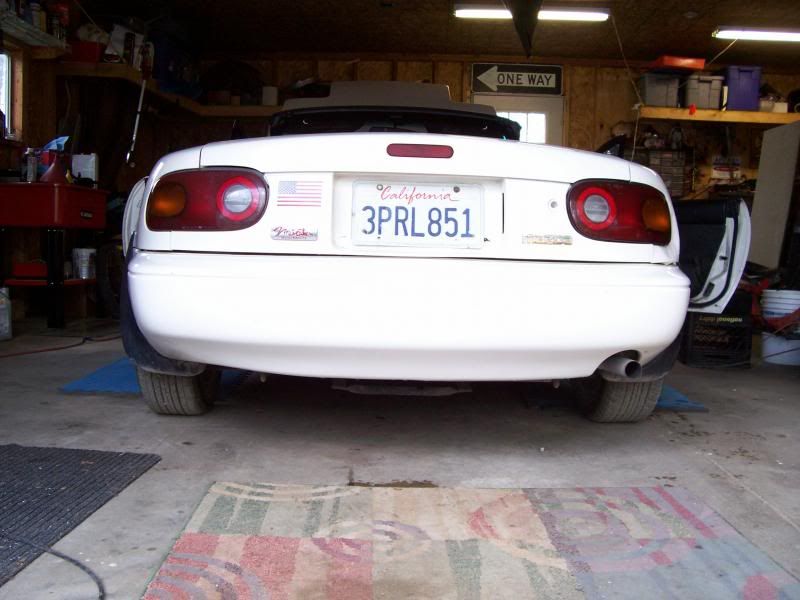 Looks like the bumper needs some trimming with a sawzall
Looks like the bumper needs some trimming with a sawzall
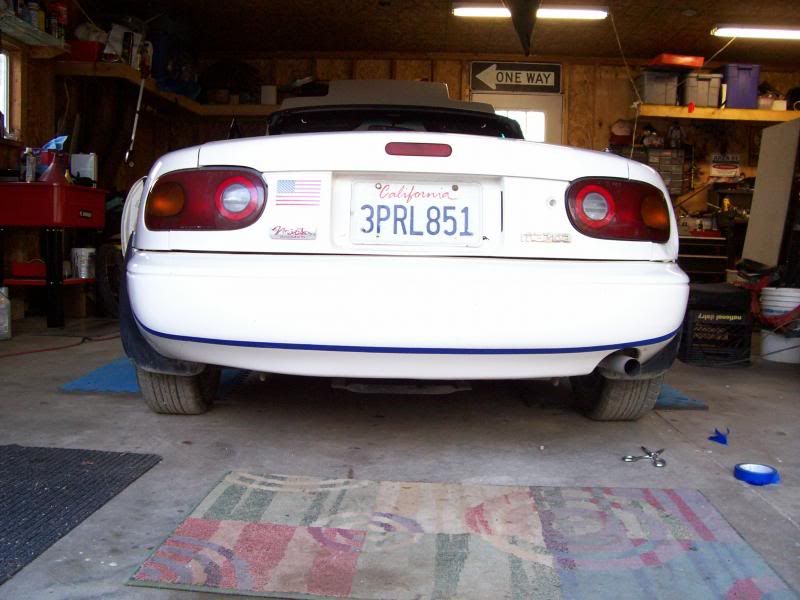
I carefully laid out some guide lines with a pencil and then used painters tape to establish a cut line.
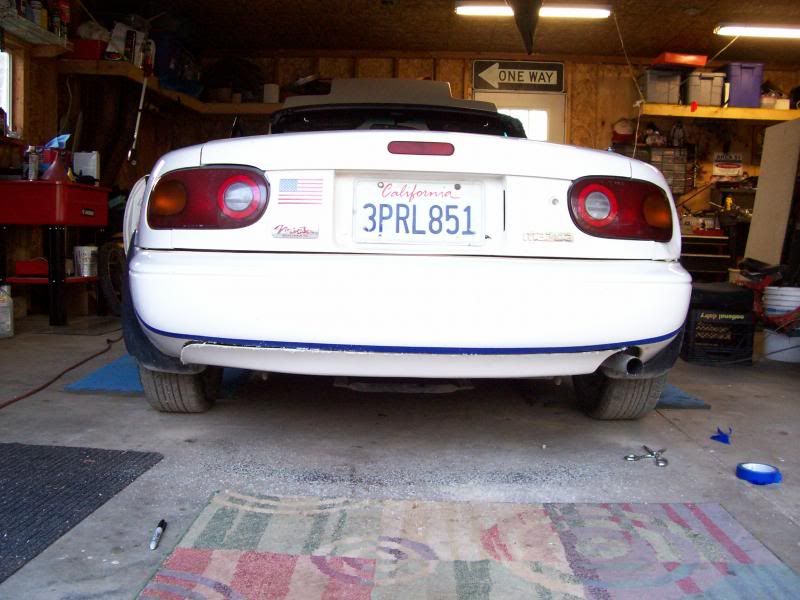
I started the surgery with an eight inch metal slicing blade with fine teeth. I dug the saw in at the exhaust cut-out and dragged the saw through the plastic bumper skin all the way to the driver’s side. When I got to the end, I turned the saw carefully to match the radius of the exhaust cut-out. I only use the tip of the blade and my first cut was the bumper skin only.
Cut is finished, next is to peel the bumper skin back and punch the plastic rivets through.
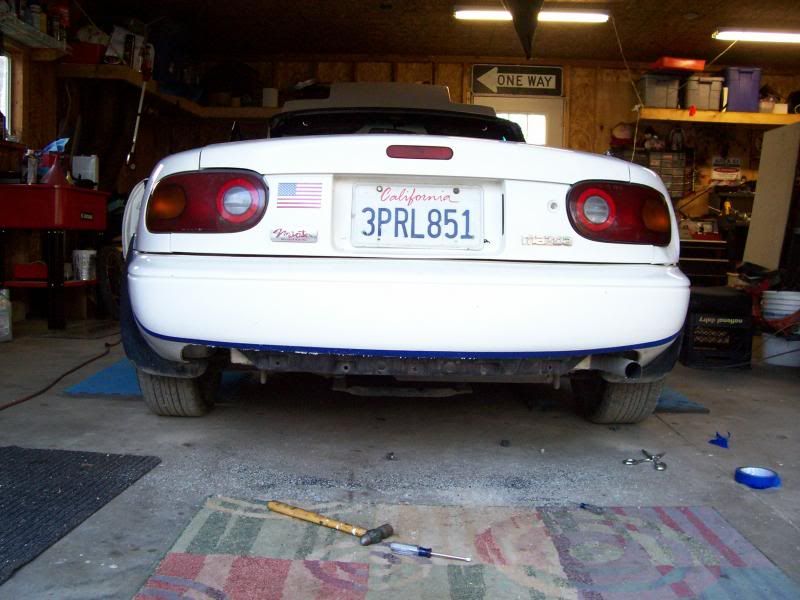
Next, the inner plastic thingy needs to be trimmed. This requires some finesse with the saw, but isn’t as critical as cutting the bumper skin.
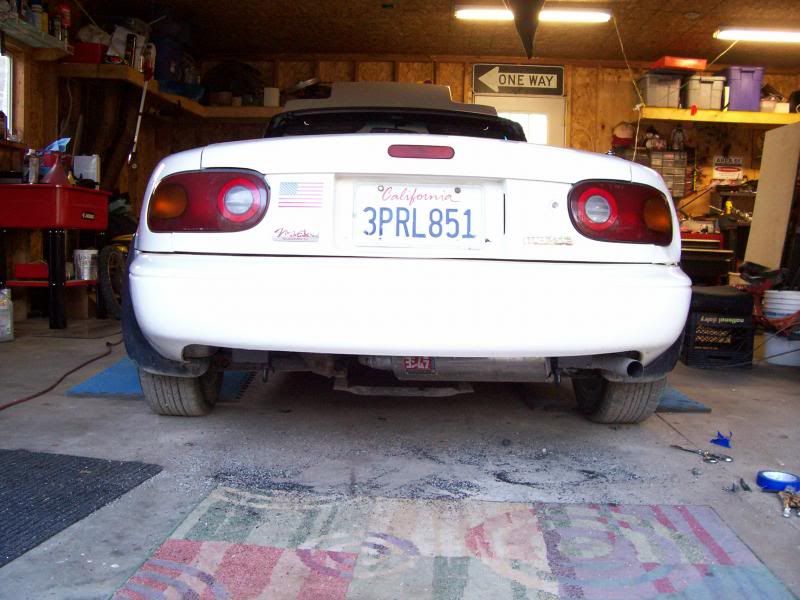 Look'n good!
Look'n good!
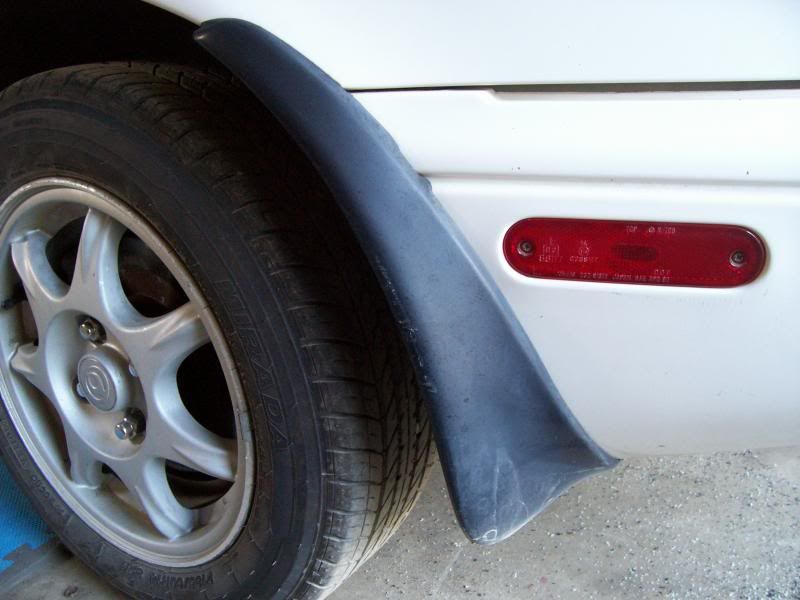
These silly things have got to go. Sold 'em for $39.00 on ebay yesterday.
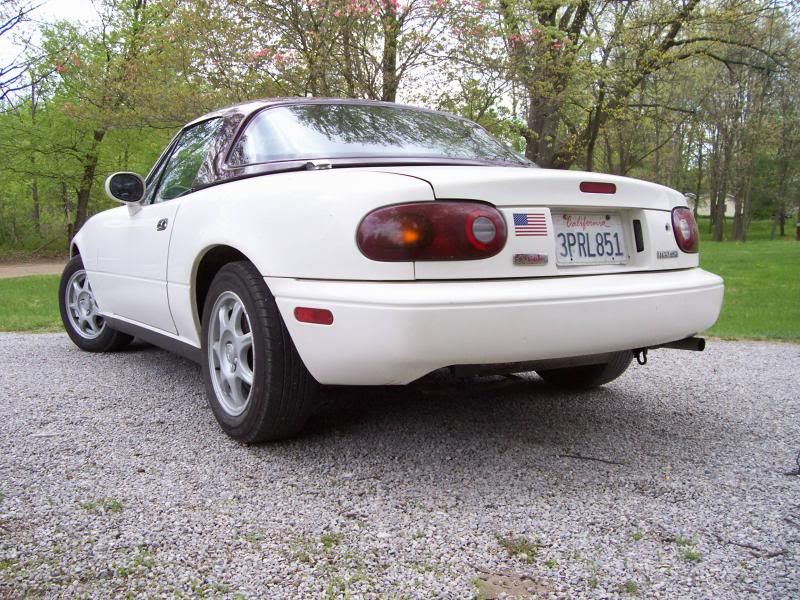
I also removed the roll bar and the soft top for weight savings. I like the look of the soft top, but I never seem to put the top down anymore. I’ll run with the hard top this season.
The Miata is a few days from hitting the 50K mile mark since I completed the B3 engine swap. From April to the first snow in December the car is my daily driver. The 1.3L engine develops horsepower in the double digit range but the torque peaks at an almost lazy 3000 rpm. The 4.10 Torsen axle does its best to keep the rear wheels from breaking loose, but wheel spin happens a lot more than you would think. I plan to swap in a 3.90 ring and pinion to better utilize the low-end torque.
I honestly do not know the actual horsepower this engine develops but the basic B3 was only rated for 63 ponies @ 5000 rpm. I programmed the Megasquirt to cut fuel at 4200 rpm because it's easy to forget that this is an economy car. Normally the B3 starts to suffocate above 4200 rpm and will fall flat on its face, however this engine seems to have picked up a little more top end since I did some head work a few years ago.
You never know what your going to find under the hood of a Miata. If you're lucky, the engine bay is stuffed with a LSx or a 5.0. Sometimes the bizarre is equally as interesting and I have found this project to be as fun as a turbo or V8 swap. The original goal was to build something that got 45-50 MPG and had personality. Sure I could write a check and take home a new off the shelf econobox but that's not how I'm wired. I would rather drive a nurtured Miata than a Prius. At the end of the day, the B3 Miata returns a respectable 42 to 45 MPG ... not too shabby.
I apologize for not updating this thread as often as I should. It takes an enormous amount of time to track the results and often its two steps forward with one step back. Earlier this year I decided to build a bench dyno to speed up the development and to do some off the wall experiments. I started a new thread on the dyno project a few months ago https://grassrootsmotorsports.com/forum/build-projects-and-project-cars/fujioko-builds-a-low-buck-engine-dyno/87005/page1/
The dyno is the tool I need to help me achieve my ultimate goal of 50 MPG. It's a big toy but it's also an integral part of this project.
I recently put the finishing touches on the dyno and it's ready to be powered up and begin some basic tests. Unfortunately I'm also mired in a huge home improvement project that is absorbing 100% of my free time. I should be wrapping up the house project in the next week or so and start posting again.
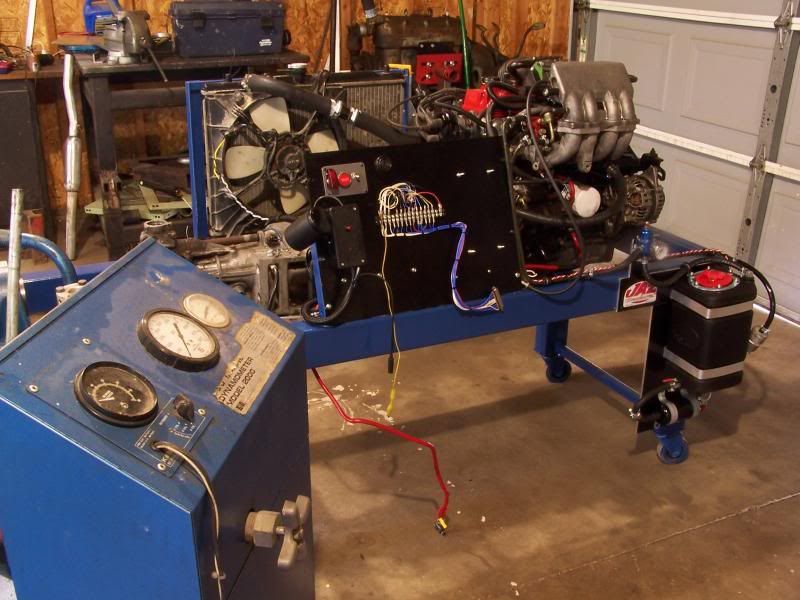
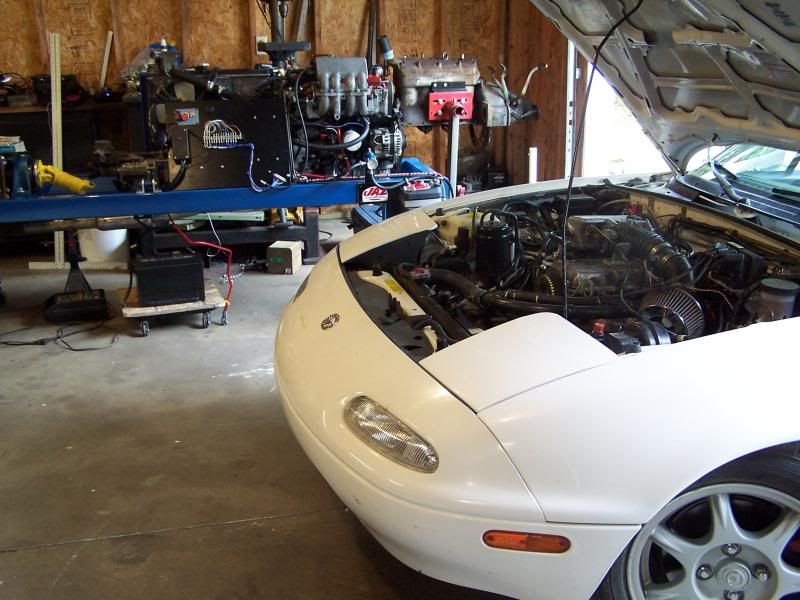 the B3 Miata and the B3 Dyno are actually part of the same project. I suck at bowling and golf so this is what I do to amuse myself.
the B3 Miata and the B3 Dyno are actually part of the same project. I suck at bowling and golf so this is what I do to amuse myself.
Stay tuned!
This thread is awesome, i would dd the hell out of that. If your really trying to hit the 50 mpg mark, I would strongly recommend so LRR tires. Probably have to switch to 15s but if you could find a lightweight 15 and some 186/50/15s you might pick up a few mpg just from the switch.
have you looked into a Warm Air Intake (opposite of a Cold Air Intake)?
Doing very cool things here man. Keep up the updates!
Definitely a cool project...and that bumper mod actually looks pretty easy and made a big difference visually. Did you notice any less drag?
The LRR tires is a great idea. I was just looking at a Chevy Volt in the parking lot and was wondering why the tires actually looked good on the car. I figured the Volt would use crappy donuts but the tires are actually fairly wide. I’ll have to look into this.
The current rims are stock 14 inchers and weigh something like eleven pounds each. Hard to beat as far as weight goes but not much choice in tires. Apparently no LRR tires are being offered for my current setup. Last season I dropped the car with a set of Tein lowering springs and had a custom alignment done to dial out the hella camber. I’m one of those people that like useless camber but In the name of science I had the camber neutralized.
Aero mods are really hard for me to determine what works and what doesn’t. The rear bumper chop looks cool so it must work,![]() .. however I have no data to support that claim
.. however I have no data to support that claim![]()
The front air dam idea will get some attention again. The last attempt I made with front aero mods resulted in the car overheating so I moved on to other tweaks.
Stay tuned!
Talking about wheel weights, have you considered the smallest brake rotors to help reduce rotating mass?
In reply to Autolex:
The car is set up to draw air from the hottest part of the engine compartment. I have datalogged as high as 160F for intake air during the mild Michigan summers. Unfortunately I don't know what the intake temp is on real hot days (85F + degrees). The fuel economy does appear to go up on hotter days.
Last fall I experimented with pre-warming the fuel before it reached the fuel rail. I had to rearrange the feed so the hot fuel deadheaded at the rail and wasn't returned to the tank. A vapor relief valve was added to combat vapor lock. The fuel warming experiment yielded positive results when ambient temps were in the teens, however as soon as the ambient temps reached above 60F the gas mileage dropped off.
One of the possible factors for the poor results is I allowed Megatune to clean up the VE tables while the car was running hot fuel. I need to re-visit this experiment with the dyno.
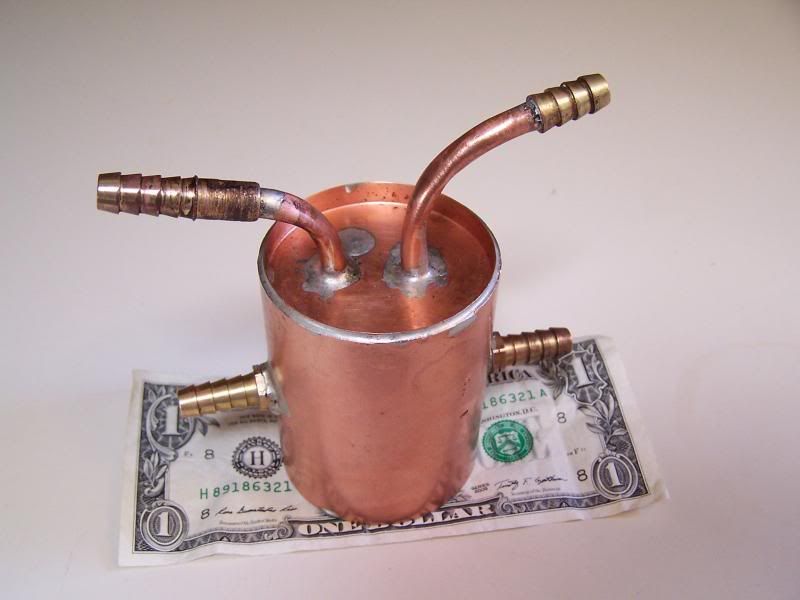 Gasoline heat exchanger used engine coolant to raise the temperature of the fuel. A fire extinguisher was on hand every time I drove the car. I racked well over 1000 miles with this setup.
Gasoline heat exchanger used engine coolant to raise the temperature of the fuel. A fire extinguisher was on hand every time I drove the car. I racked well over 1000 miles with this setup.
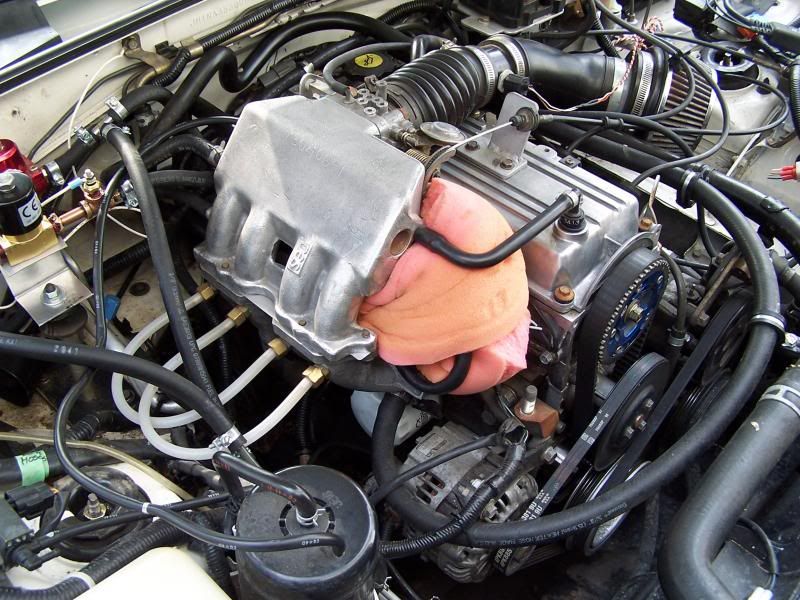 Here is the car running the hot fuel experiment. The fuel rail was insulated with foam to help hold in the heat. You can also see the location of the cheesy chrome air filter that is sucking air right above the exhaust manifold.
Here is the car running the hot fuel experiment. The fuel rail was insulated with foam to help hold in the heat. You can also see the location of the cheesy chrome air filter that is sucking air right above the exhaust manifold.
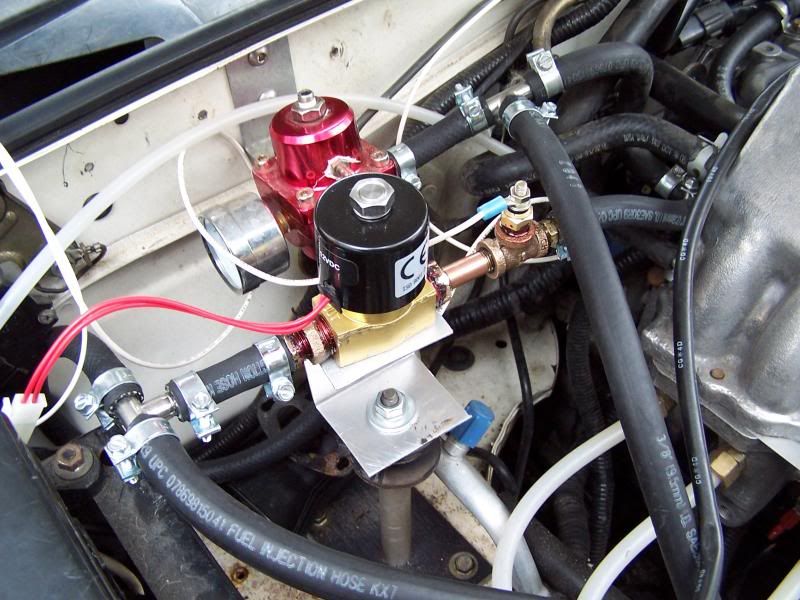 To combat vapor lock on the deadhead fuel routing, I added a relief valve to purge the fuel lines. All the heat was localized at the fuel rail and none of the heated fuel was sent back to the tank.... unless the lines were being purged.
To combat vapor lock on the deadhead fuel routing, I added a relief valve to purge the fuel lines. All the heat was localized at the fuel rail and none of the heated fuel was sent back to the tank.... unless the lines were being purged.
Stay tuned!
fujioko wrote: In reply to Autolex: The car is set up to draw air from the hottest part of the engine compartment. I have datalogged as high as 160F for intake air during the mild Michigan summers. Unfortunately I don't know what the intake temp is on real hot days (85F + degrees). The fuel economy does appear to go up on hotter days.Here is the car running the hot fuel experiment. The fuel rail was insulated with foam to help hold in the heat. You can also see the location of the cheesy chrome air filter that is sucking air right above the exhaust manifold. Stay tuned!
Very Cool!
I'm sure that underhood temps drop at speed, you could draw directly off the exhaust mani to fix that?
Opti wrote: What are the lines running between the intake runners.
Uhhh... well... they were for a insane experiment that I decided not to try....yet. Anyway, the lines were intended to be vapor ports for a very unconventional fuel atomizer. The device was nicknamed "Mr. Fusion" cause it looked like something from "Back to the future". Long story short, Mr. Fusion has issues with the ceramic ultrasonic transducer cracking and some explosion issues as well.
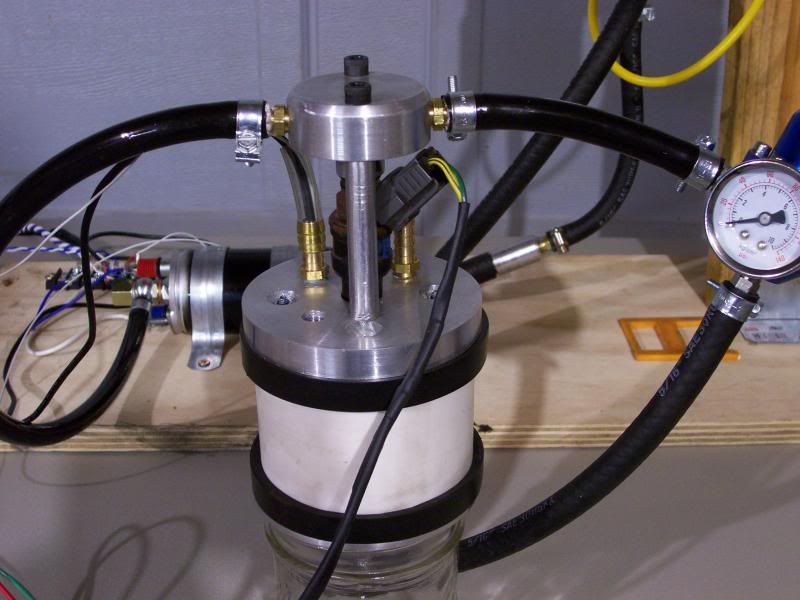 Mr. Fusion... Kids, don't try this at home.
Mr. Fusion... Kids, don't try this at home.
I made a short video on how Mr. Fusion works.... http://youtu.be/42v3YQnkJNg
Anyway, I have re-purposed Mr. Fusion as a fuel volume measurement tool. It will make it's grand re-appearance soon.
I have done a fair amount of mad scientist experiments on my poor Miata.
Stay tuned!
In replay to Ross
The early Miata's were equipped with smaller less effective brakes so theoretically I could swap in early Miata brakes. This car sees some spirited driving but probably not enough to justify larger '94 and up brakes that are currently on the car. Certainly something to consider, especially if I were to build another car.
in reply to Autolex
The hot air intake is one of the experiments I want to try on the dyno. One of the main issues is the probability of loosing too much power during a wide open throttle event. Realistically I need all the power I can get if the situation demands it. I gave this some more thought today and if I see positive results I can build diverter system to snorkel cold air for full power and hot air for cruise.
fujioko wrote: Realistically I need all the power I can get if the situation demands it. I gave this some more thought today and if I see positive results I can build diverter system to snorkel cold air for full power and hot air for cruise.
The air cleaners on old carbed/TBI cars are more or less designed for this.
fujioko wrote: ... Aero mods are really hard for me to determine what works and what doesn’t ... The front air dam idea will get some attention again. ... The last attempt I made with front aero mods resulted in the car overheating so I moved on to other tweaks. ...
You can evaluate aero with coastdown testing, basically a stopwatch and a tach/speedo. Kind of cumbersome, but far far cheaper than a wind tunnel, and easier to carry in your pocket.
fujioko wrote: In reply to Autolex : The hot air intake is one of the experiments I want to try on the dyno. One of the main issues is the probability of loosing too much power during a wide open throttle event. Realistically I need all the power I can get if the situation demands it. I gave this some more thought today and if I see positive results I can build diverter system to snorkel cold air for full power and hot air for cruise.
I was thinking about this (for a different application) yesterday, what about a vacuum operated lever arm? I was thinking bypass mufflers on bmw's and maximas(?) that operate only once reaching a certain vacuum level, say WFO? you could probably rig something up with a wastegate actuator (plumbed backwards)or pirated parts from a vette muffler al la This
Autolex wrote:fujioko wrote: In reply to Autolex : The hot air intake is one of the experiments I want to try on the dyno. One of the main issues is the probability of loosing too much power during a wide open throttle event. Realistically I need all the power I can get if the situation demands it. I gave this some more thought today and if I see positive results I can build diverter system to snorkel cold air for full power and hot air for cruise.I was thinking about this (for a different application) yesterday, what about a vacuum operated lever arm? I was thinking bypass mufflers on bmw's and maximas(?) that operate only once reaching a certain vacuum level, say WFO? you could probably rig something up with a wastegate actuator (plumbed backwards)or pirated parts from a vette muffler al la This
Naturally aspirated Volvo 850s have a diverter valve (flapper) built into the bottom of their air filter box, it's controlled with a spring loaded thermostat, not vacuum. The flapper allows air to enter the air filter box from either a shroud on the exhaust manifold (hot air) or from the snorkel between the headlight and radiator (fresh air). It's common for the thermostat/spring to fail and only allow air from the hot side. It's supposedly intended to prevent throttle body icing in cold climates, not really for fuel economy, though it may provide a parts/brain storming source for further tinkering.
You'll need to log in to post.